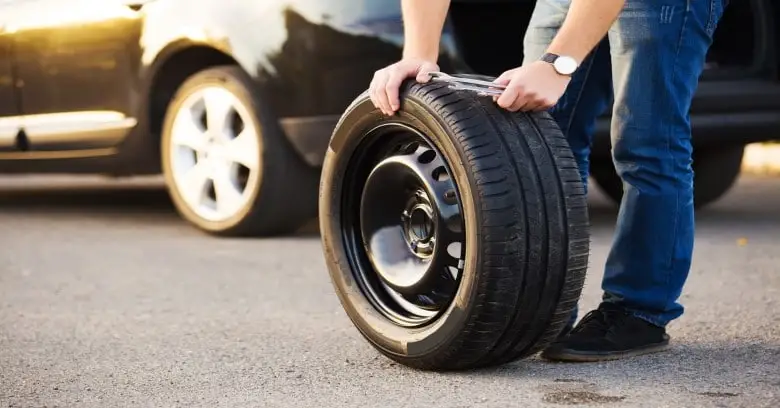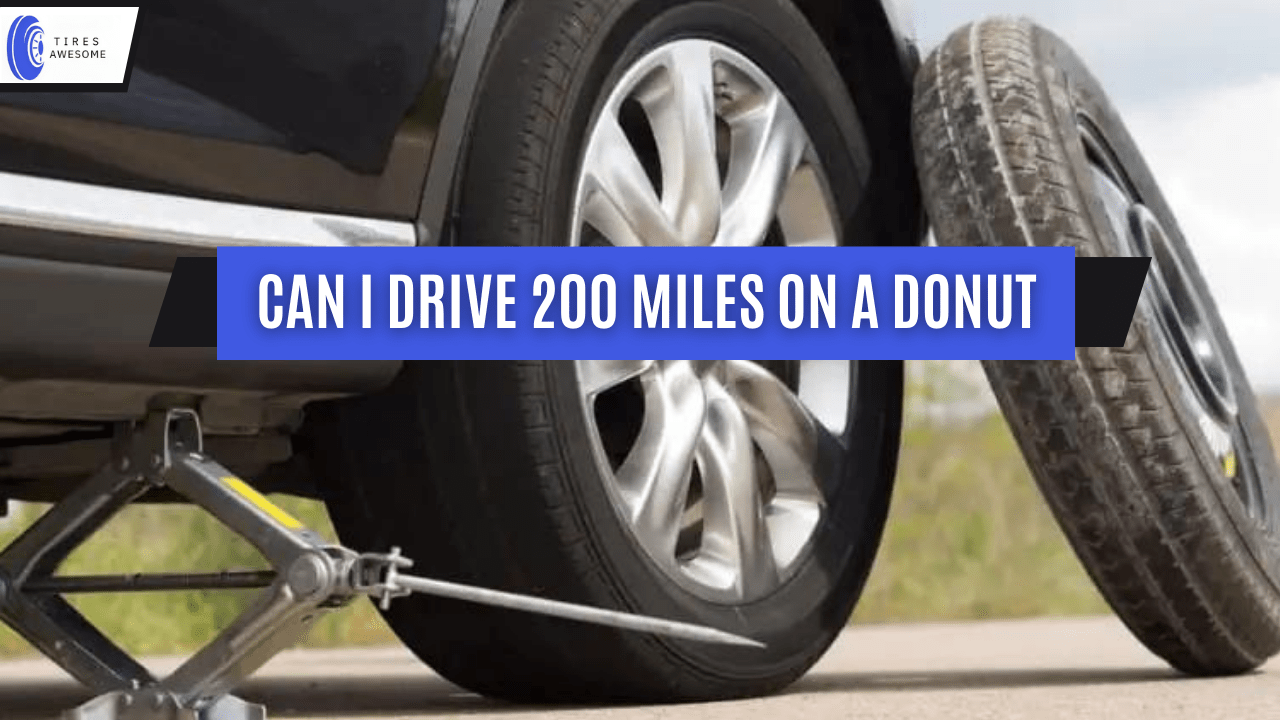Are you urgently seeking solutions to the pressing inquiry: Can I drive 200 miles on a donut? As an expert in tires, continuing our journey on that seemingly flimsy spare wheel is safe or even possible. Donut tires, called light tires or compact temporary spares, are made for temporary use after a flat tire. We’ll discuss their design, strength, and when to use them. Before a long trip, replace your donut tire with a regular one for safety and to avoid problems later on.
Is It Safe To Drive With A Donut Tire?
These compact tires are noticeably smaller and lighter than regular tires, allowing for easy storage and installation. A donut tire’s safety is contingent upon its use duration while driving.
Donut tires have thinner treads and lighter air pressure, rendering them less durable than regular tires. Using them beyond their intended lifespan can compromise your safety on the road.

Can I Drive 200 Miles On A Donut?
Donut tires are not safe for long-distance journeys. Donut tires are not built to handle the same load or road conditions as standard tires, leading to decreased stability and increased braking distances. They have a restricted speed rating that ranges from 50 to 55 mph.
Exceeding this limit could result in excessive heat buildup due to their smaller size and thinner construction. This increased heat may lead to tire blowouts or failure, putting you and other drivers at risk.
What Happens If You Drive 200 Miles On A Donut?
Exceeding the recommended limit on a donut tire can be dangerous because it can cause the lubricating grease to break down. This can lead to extra wear and tear on essential parts like the clutch plate and gears. Donut tires don’t have as much tread as regular tires, so they are more likely to be damaged by things on the road.
This affects how well they work, including how they spread weight and maintain good traction. Because donut tires are only meant for temporary use and are made differently, using them for a long time can make the wheel and the area it touches unbalanced. This imbalance creates more heat because of extra rubbing.
How Many Miles On A Donut Can I Drive?
Donuts should not be driven for more than 70 miles. This limitation is in place due to safety guidelines and should not be ignored. When traveling longer distances, it is essential to consider alternative options. Ignoring these guidelines could put the driver and other road users at risk.
How Fast Should You Drive On A Donut?
Avoid speeds exceeding 50 mph when using a spare tire. Going beyond this speed threshold could place excessive strain on the donut, leading to potential tire failure.
This size difference causes the donut to spin faster as it tries to match the speed of the other tires on the vehicle. Regular tires have robust tread patterns designed for optimal traction and durability; donuts have limited or no tread.
How Much Air In A Donut Tire?
The standard air pressure for a donut tire is 60 PSI (pounds per square inch). Having a reliable tire inflator on hand is essential, as donut tires tend to spend most of their time stored away.
Excessive air pressure can make the ride uncomfortable and potentially damage the tire. Over-inflation may lead to greater vulnerability to punctures and blowouts, which could leave you stranded on the side of the road.
Tips For Driving On A Donut Tire: Dos And Don’ts
When driving on a donut tire, it’s essential to adhere to certain dos and don’ts for your safety on the road. Ensure you go at a reduced speed, as donut tires are not designed for high-speed travel and can affect vehicle stability. Prioritizing repairing or replacing your regular tire immediately is essential to avoid further damage or risk. Below are the guidelines for driving with a temporary spare tire:
Dos Of Driving On A Donut
- Maintain a moderate speed: When driving with a donut spare tire, keeping your speed in check is crucial. The donut is not designed for high-speed driving, and exceeding the recommended limit can lead to dangerous situations. Stick to gentle acceleration and reduce your overall speed to ensure a safe journey.
- Check tire pressure regularly: Donut spare tires are significantly smaller than regular tires, requiring a higher air pressure. It’s essential to monitor the tire pressure of your donut regularly, especially before embarking on long journeys. Proper inflation will enhance the durability and performance of the spare tire, providing you with peace of mind during your travels.
- Limit distance and avoid extreme conditions: While the purpose of a donut spare tire is to get you to a nearby service center for proper repairs or replacement, it’s essential not to push its limits too far. Avoid driving long distances on a donut and using it in extreme weather conditions or rough terrains whenever possible. This will help preserve the integrity of the spare tire and ensure your safety on the road.
Don’ts Of Driving On A Donut
- Don’t exceed the recommended speed limit: Driving on a donut tire is a temporary solution, not a long-term fix. It’s crucial to adhere to the manufacturer’s guidelines for maximum speed when using a spare tire. Exceeding this limit can compromise your safety and the stability of your vehicle, leading to potential accidents or further damage.
- Don’t forget to check your tire pressure: Since donut tires are smaller and have different pressure requirements than regular tires, it’s essential to monitor their air pressure regularly. Neglecting this step can reduce handling and braking capability, putting you at risk on the road.
- Don’t drive long distances on a donut: While it may be tempting to continue driving with a donut tire due to convenience, it’s essential to remember that these tires are designed for short distances only. Prolonged use can impact your car’s alignment and suspension components, incurring additional repair costs.
Will A Donut Tire Fit Any Car?
No, each donut tire has specific dimensions, including height, width, tread, and material, unique to the car it comes with. No universal donut tire can fit all vehicles, even with similar lug nuts.
Different spare tires may have varying distance and speed ratings printed on them, indicating their limitations for use. Check the compatibility of a donut tire with your specific vehicle before attempting to use it as a replacement in an emergency.
Can A Donut Spare Tire Be Repaired?
No, these temporary spare tires are not as solid or durable, having shallow treads and thin rubber, making them vulnerable to damage. Donut spare tires, also called compact spare tires, are only for temporary use and should not be fixed. These tires are smaller and lighter than regular tires, so they are only suitable for short distances at low speeds.
Donut spare tires are not as strong as regular tires, so that they can be damaged more easily. Trying to fix a donut spare tire could make it unsafe and put you at risk of another flat tire or blowout. Instead of setting a donut spare tire, they immediately replace it with a new one to stay safe on the road.
Conclusion
Donut tires help you keep driving until you can fix or replace your tire. They are meant for short distances and lower speeds, so they prepare you for unexpected problems on the road. I hope you understand from today’s post: Can I drive 200 miles on a donut? Driving is not recommended; donut tires are highly functional in critical situations. Despite their unattractive appearance, their compact size allows for convenient storage in the car trunk, making them easily accessible whenever necessary.
FAQs
Can You Drive With A Donut On The Front Tire?
Putting a donut on the front tire and driving, even if it’s just for a short distance, is not advisable. This is particularly true for vehicles with engines in the front, as they tend to be heavier. The front wheels bear most of the load when braking, turning, and accelerating.
Who Invented The Donut Tire?
Walter and Tom Davies from Wales invented the spare tire in 1904 for the motor cars made by their company, Stepney Iron Mongers. Repairing a tire includes taking it off, fixing the inner tube, putting the inner tube and tread back on, inflating the tire, and then putting the wheel back on the vehicle.
What Is A Spare Tire Called A Donut?
A stepney, a spare wheel, is an extra tire found in vehicles. Its purpose is to serve as a backup in case any tire encounters problems while driving, such as low air pressure, a puncture, or even a tire burst.
How Long To Drive 200 Miles?
Several factors affect how long it takes to drive 200 miles, including speed limit, traffic, and your car’s efficiency. Driving at a steady 60 miles per hour would take about 3 hours and 20 minutes. But if there’s heavy traffic or lower speed limits in urban areas, it could take longer.

